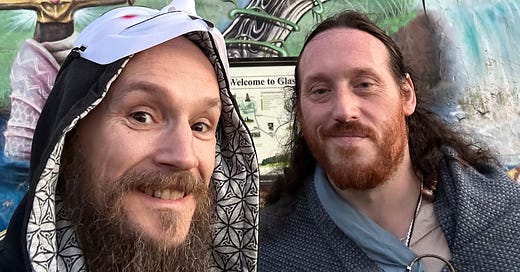Samhain in Glastonbury: A Celebration of Death, Rebirth, and Dragons
Samhain, pronounced "Sow-in," is an ancient Celtic festival marking the end of the harvest and the beginning of winter. Celebrated on the cusp of November 1st, it's a liminal time, a threshold between summer and winter, the world of the living and the spirit world. Some believe it to be the Celtic New Year, a time for reflection, feasting, and connecting with the otherworld. And nowhere is this connection more palpable than in Glastonbury, a town steeped in mysticism and tradition.
Samhain's roots lie in Celtic paganism, with early references appearing in 9th-century Irish Christian literature. These texts describe gatherings, feasts, and contests, often serving as a backdrop for Irish tales. Samhain was one of the great fire festivals, a time for stocktaking, winter preparations, and offerings to appease the spirits of the dead. Ancient burial mounds were believed to be portals to the otherworld, and a place was set at the table for departed kin.
Irish mythology paints Samhain as a time when the doorways to the Otherworld opened, allowing supernatural beings and the souls of the dead to enter our world. Tales of fire-breathing trolls, otherworldly beings stealing roasts, and werewolves emerging from caves highlight the potent connection between Samhain and the spirit realm.
Samhain embodies the concept of death and rebirth. The dying of the year mirrors the passage of time and the loss of loved ones, yet it also signifies the promise of renewal. It's a time for honoring ancestors, sharing stories, lighting candles, and leaving offerings. Bonfires are lit to ward off evil spirits, and people often jump over the flames for cleansing and good fortune. Divination practices, like tarot cards and runes, are common, and communities gather to share food and drink.
Samhain's legacy lives on in modern Halloween traditions. Costumes likely originated from the Celtic practice of disguising oneself from malevolent spirits. Mumming and guising, where people went door-to-door in costume for food, also have roots in Samhain. Jack-o'-lanterns, with their carved faces and flickering candles, echo the ancient custom of using hollowed-out turnips to ward off evil.
Today, Samhain continues to be celebrated by Pagans, Wiccans, and those seeking a connection with nature and ancestral traditions. It's a time for introspection, gratitude, letting go of the old, and making way for the new. And in Glastonbury, this ancient festival is brought vividly to life.
Glastonbury, a town renowned for its mystical atmosphere, embraces Samhain with unique traditions. The town's sacred wells, the White and the Red, are sites of ancient significance and healing waters. The White Well, housed in a Victorian pump station, contains shrines to the Lady of Avalon, the King of the Fairies, and the fire goddess Brigid. The Red Well, also known as the Chalice Well, is said to be where Joseph of Arimathea placed the Holy Grail, giving the water its iron-rich taste and reddish tinge.
Perhaps the most spectacular Samhain tradition in Glastonbury is the awakening of the dragons. Two enormous red and white figures are brought to life, parading through the town and battling for seasonal dominance. This relatively recent tradition (around nine or ten years old) has become a focal point of Glastonbury's Samhain celebrations, bringing the community together in a vibrant and inclusive spectacle. It's a celebration that blends pagan roots with a modern, welcoming spirit, emphasizing that traditions belong to the land and are there for everyone to observe and enjoy.
For many, Samhain is a time for reflection, shedding the past year, and embracing new beginnings. It's a somber yet joyous occasion, a time to honor ancestors and celebrate life's cyclical nature. Glastonbury, with its vibrant community and unique traditions, embodies the spirit of Samhain, a festival that connects the past, present, and future, reminding us of the eternal dance of death and rebirth.
Check out our recent podcast from Glastonbury here



